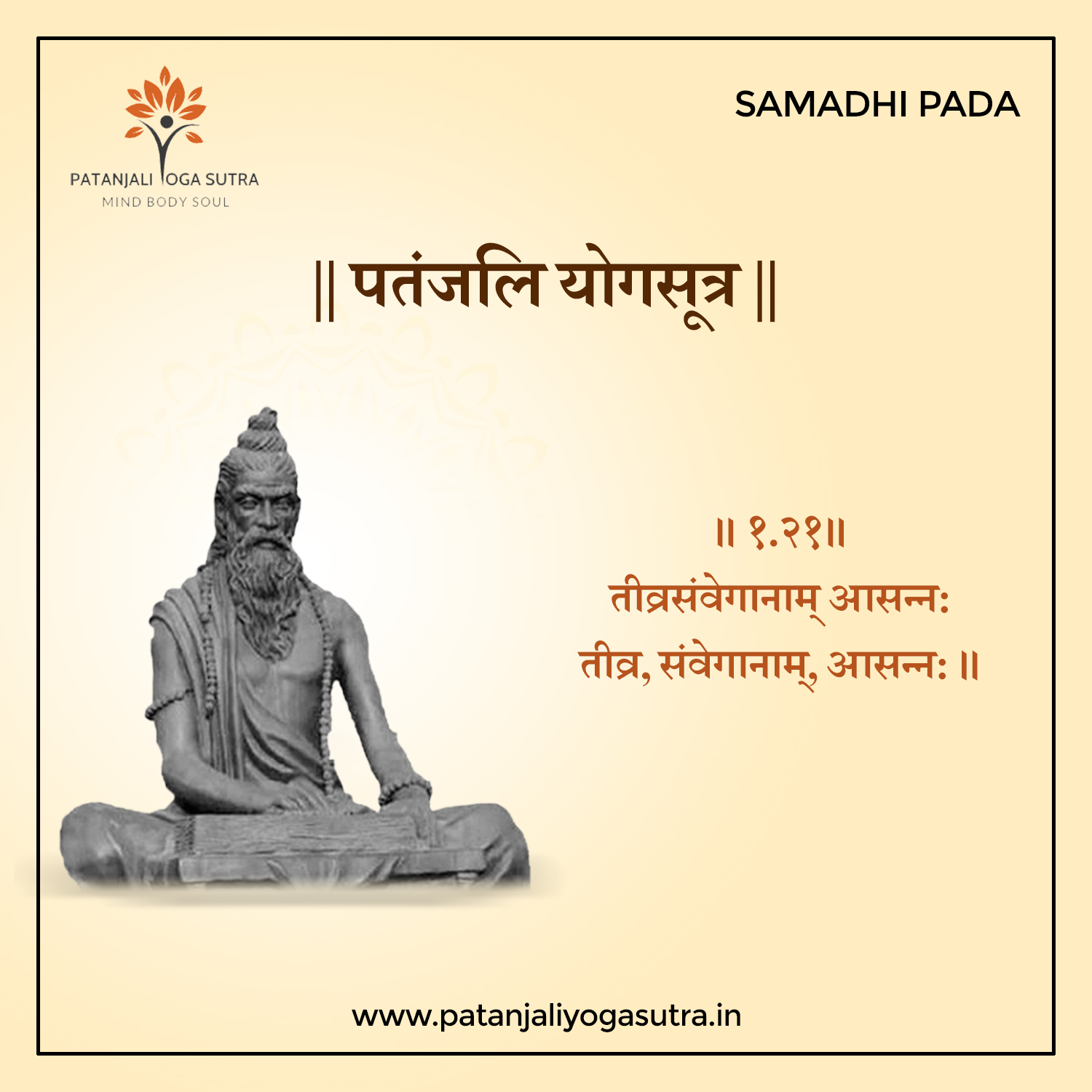



योग में किसकी कितनी तीव्र इच्छा है उसके अनुसार योगी मृदु, मध्य और अधिमात्र उपाय के मुख्य तीन आधारों के अनुसार 9 प्रकार के होते हैं।
मृदु उपाय के भी तीन प्रकार होते हैं-
इसी प्रकार से मध्य और अधिमात्र उपाय भी समझ लेने चाहिए। अब अधिमात्र उपाय वाले योगियों की योग में समाधिप्राप्ति किस प्रकार होती है उसे इस सूत्र के माध्यम से महर्षि शिष्यों को समझा रहे हैं।
“गहरे एवं ऊंचे विवेकज्ञान, पर वैराग्य एवं अभ्यास वाले योगियों को अतिशीघ्र ही समाधि एवं समाधि के फल की प्राप्ति होती है।”
यहां महर्षि बता रहे हैं कि यदि साधक ऊंचे वैराग्य और अभ्यास को पूर्ण विवेक के साथ साधता हुआ साधना में आगे बढ़ रहा है तो उसके समाधिस्थ होने में समय की कोई सीमा नहीं है, अर्थात वह अतिशीघ्र ही समाधि के लाभ और समाधि के फल को प्राप्त हो सकता है।
व्यास भाष्य में दो शब्दों का प्रयोग किया गया है वह हैं
समाधिलाभ:- तीव्र अभ्यास और वैराग्य से समाधि की प्राप्ति को ही समाधिलाभ कहते हैं। यदि तीव्र अभीप्सा है तो समाधि शीघ्र ही मिल सकती है लेकिन योगियों के 9 प्रकार होने से साधनों का अनुष्ठान भी न्यूनाधिक हो सकता है, इसलिए समाधि लगने में समय भी कम और अधिक हो सकता है। लेकिन महर्षि ने यह स्पष्ट किया है कि कोई निश्चित समय सीमा नहीं है समाधि लगने की यह कम और अधिक हो सकती है योगियों के पुरुषार्थ के अनुसार।
सांख्य दर्शन के एक सूत्र में महर्षि कपिल ने भी इसी बात को कहा है। “न काल नियमो वामदेववत” अर्थात जिस प्रकार वामदेव ने योग के आठ अंगों, अभ्यास और वैराग्य का श्राद्ध पूर्वक, निरंतरता के साथ अनुष्ठान करने से अत्यंत कम समय में समाधि और कैवल्य को प्राप्त कर लिया था उसी प्रकार के साधनों का तीव्रता से अनुष्ठान करने से कोई भी अन्य योगी प्राप्त कर सकता है।
समाधिफल- समाधि की प्राप्ति के बाद साधक को जो अनुभव होते हैं या जो स्थितियां प्राप्त होती हैं उन्हें समाधि का फल कहते हैं।
There are total 9 types of yogis based on the intensity of their conviction in Yoga: mridu (mild), medium and Supreme, with three sub divisions of each.
Mild intensity too has three sub divisions:
Similarly Medium and Supreme intensity should be understood. Through this narrative, Maharshi is making his pupils understand how the yogis with supreme intensity achieve Yoga Samadhi.
“Samadhi and its fruits are obtained quicker by a yogi with deep wisdom, complete detachment and intense practice.”
Here Maharshi says that there is no time limit to attain Samadhi if the meditator is moving forward in sadhana with high level of detachment and intense practice with full concentration. It means that Samadhi and its fruits are quicker to achieve with determined and intense practice.
In Vyasa commentary the following two words have been used:
Samadhilabha: Attaining Samadhi by means of intense practice and detachment is called success in Samadhi. Samadhi is achieved quicker if the desire is intense. But due to nine types of yogis, practitioners’ degree of efforts can be more or less. Therefore, time period can vary in succeeding in Samadhi. Maharshi has clarified that there is no fixed time limit to attain Samadhi as it can vary according to the efforts of yogis.
In one sutra of Sankhya Darshan Maharshi Kapil has also said this: “Na kal Niyamo Vamadeva” i.e. the way Vamadeva had achieved Samadhi and Kaivalya in a very short time by faithfully performing rituals of eight limbs of yoga with intense constant practice of detachment, other yogis can also succeed in it by putting in intense efforts.
Samadhiphal: The experience of the meditator or the states he gets in after the attainment of Samadhi the reward of Samadhi.
सूत्र: तीव्रसंवेगानाम् आसन्न:
तीव्र अभीप्सा समाधि लाभ की
न हो इच्छा जब पुण्य पाप की
निरंतर अभ्यास और ऊंचा वैराग्य जब
तत्क्षण भी मिल सकता समाधि लाभ तब
समय की कोई सीमा न रहती
चित्त नदी प्रशांत वाहिता हो बहती
इसलिए तीव्र अभीप्सा एक और उपाय है
शीघ्र समाधि लाभ में वह सहाय है
शीघ्र समाधि लाभ में अवश्य सहाय है।
It’s impressive that you are getting ideas from this
paragraph as well as from our dialogue made here.
Thanks
The website was not available for the last few days… delighted you get my daily dose of knowledge